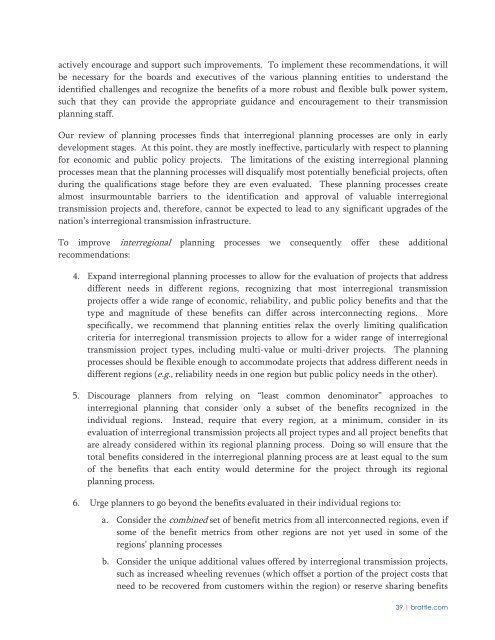THE BRATTLE GROUP
pvrbYG
pvrbYG
Create successful ePaper yourself
Turn your PDF publications into a flip-book with our unique Google optimized e-Paper software.
actively encourage and support such improvements. To implement these recommendations, it will<br />
be necessary for the boards and executives of the various planning entities to understand the<br />
identified challenges and recognize the benefits of a more robust and flexible bulk power system,<br />
such that they can provide the appropriate guidance and encouragement to their transmission<br />
planning staff.<br />
Our review of planning processes finds that interregional planning processes are only in early<br />
development stages. At this point, they are mostly ineffective, particularly with respect to planning<br />
for economic and public policy projects. The limitations of the existing interregional planning<br />
processes mean that the planning processes will disqualify most potentially beneficial projects, often<br />
during the qualifications stage before they are even evaluated. These planning processes create<br />
almost insurmountable barriers to the identification and approval of valuable interregional<br />
transmission projects and, therefore, cannot be expected to lead to any significant upgrades of the<br />
nation’s interregional transmission infrastructure.<br />
To improve interregional planning processes we consequently offer these additional<br />
recommendations:<br />
4. Expand interregional planning processes to allow for the evaluation of projects that address<br />
different needs in different regions, recognizing that most interregional transmission<br />
projects offer a wide range of economic, reliability, and public policy benefits and that the<br />
type and magnitude of these benefits can differ across interconnecting regions. More<br />
specifically, we recommend that planning entities relax the overly limiting qualification<br />
criteria for interregional transmission projects to allow for a wider range of interregional<br />
transmission project types, including multi-value or multi-driver projects. The planning<br />
processes should be flexible enough to accommodate projects that address different needs in<br />
different regions (e.g., reliability needs in one region but public policy needs in the other).<br />
5. Discourage planners from relying on “least common denominator” approaches to<br />
interregional planning that consider only a subset of the benefits recognized in the<br />
individual regions. Instead, require that every region, at a minimum, consider in its<br />
evaluation of interregional transmission projects all project types and all project benefits that<br />
are already considered within its regional planning process. Doing so will ensure that the<br />
total benefits considered in the interregional planning process are at least equal to the sum<br />
of the benefits that each entity would determine for the project through its regional<br />
planning process.<br />
6. Urge planners to go beyond the benefits evaluated in their individual regions to:<br />
a. Consider the combined set of benefit metrics from all interconnected regions, even if<br />
some of the benefit metrics from other regions are not yet used in some of the<br />
regions’ planning processes<br />
b. Consider the unique additional values offered by interregional transmission projects,<br />
such as increased wheeling revenues (which offset a portion of the project costs that<br />
need to be recovered from customers within the region) or reserve sharing benefits<br />
39 | brattle.com


